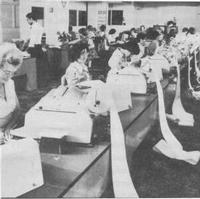


Chapter 8
I Part 1: Communications
i Before the Telegraph
ii Electrical Communication Before Federation
iii Federation to the End of the Second World War
iv Post-war and on to 1975
v 1975 ONWARDS
II Epilogue
III Part 2: Early Australian Computers And Computing
IV Acknowledgements
References
Index
Search
Help
Contact us

Post-war and on to 1975 (continued)
The history of FM radio in Australia goes back to the early 1940s, when a Joint Parliamentary Committee reported (the Gibson Report) to parliament on a number of broadcasting issues. Then in 1947, a Parliamentary Standing Committee concluded that decisions in connection with the introduction of FM broadcasting should be deferred pending the outcome of practical tests in capital cities by the PMG Department. Shortly afterwards experimental stations were established by the APO and continued in operation until 1961, but for a variety of reasons neither national or commercial FM was established in the period under review. One factor of particular significance occurred in 1961, when the Huxley Committee proposed, and the Government accepted, that the frequencies used internationally for FM broadcasting, 88-108 MHz should be reserved to provide for three additional TV channels. Then in 1972, the ABCB proposed that Australia should introduce FM using the UHF band, but the McLean Report in 1974 resulted in a decision that FM should operate here in the VHF band as elsewhere in the world.A century after the telegraph service had been introduced, growth in the telephone trunk line service and the introduction of telex were eroding telegraph business. As one means of improving the standard of service while containing costs of the public telegram service, a Teleprinter Reperforator Switching System, 'Tress', was developed in 1959, by a team which included B. Edwards, R. Kerr and P. Bethell, using Siemens and Halske equipment in a configuration to meet Australian conditions, but drawing on experience of the Western Union (USA) Message Switching System. Basically the system involved storing all messages on perforated tape at the Chief Telegraph Office in capital cities and forwarding to nominated post offices or printergram terminals when switching equipment, links and receiving equipment were available for transmission. The system involved intrastate messages being switched only once and interstate messages twice.[31] Telex was introduced on a manually switched basis in 1954 and converted to automatic in 1966, using a telex version of L. M. Ericsson crossbar equipment and using CCITT type B trunk signalling. An Australia wide five digit stored numbering scheme was adopted with multi-metering for call charging.

Facilities for the transmission of data, the Datel service, were introduced in 1969, with options of using the switched telephone service for lower speeds, or leased lines for higher speeds. Modems supplied by the APO were an essential part of the service and by 1973, nearly 2,500 were in use. In 1970, the APO, to provide for the increasing demand for data communications by a number of large customers, such as airlines and weather services, let a contract with the UNIVAC division of Sperry Rand Australia Ltd. for the provision of a Common User Data Network (C.U.D.N.), with installations in all mainland State capital cities. CUDN was a store and forward message switching system, designed to transfer data quickly and reliably from one location to one or more specified distant locations, using magnetic disc packs for storage and with computers performing the routing functions. The system was designed to enable several customers to use the service concurrently.[32]
Organisations in Australian Science at Work - Australian Post Office (A.P.O.); CCITT (International Consultative Committee for Telephony and Telegraphy); Radio Australia; Sperry Rand Australia Ltd
People in Bright Sparcs - Bethell, P.; Edwards, B.; Kerr, R.
 |
Australian Academy of Technological Sciences and Engineering |  |
© 1988 Print Edition pages 568 - 570, Online Edition 2000
Published by Australian Science and Technology Heritage Centre, using the Web Academic Resource Publisher
http://www.austehc.unimelb.edu.au/tia/552.html